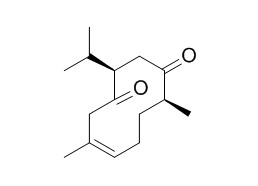Neocurdione
Neocurdione is an attachment inhibitor against the blue mussel, Mytilus edulis galloprovincialis. Neocurdione shows a protective effect against D-GalN/tumor necrosis factor-alpha-induced liver injury in mice at a dose of 50 mg/kg p.o.
Inquire / Order:
manager@chemfaces.com
Technical Inquiries:
service@chemfaces.com
Tel:
+86-27-84237783
Fax:
+86-27-84254680
Address:
1 Building, No. 83, CheCheng Rd., Wuhan Economic and Technological Development Zone, Wuhan, Hubei 430056, PRC
Providing storage is as stated on the product vial and the vial is kept tightly sealed, the product can be stored for up to
24 months(2-8C).
Wherever possible, you should prepare and use solutions on the same day. However, if you need to make up stock solutions in advance, we recommend that you store the solution as aliquots in tightly sealed vials at -20C. Generally, these will be useable for up to two weeks. Before use, and prior to opening the vial we recommend that you allow your product to equilibrate to room temperature for at least 1 hour.
Need more advice on solubility, usage and handling? Please email to: service@chemfaces.com
The packaging of the product may have turned upside down during transportation, resulting in the natural compounds adhering to the neck or cap of the vial. take the vial out of its packaging and gently shake to let the compounds fall to the bottom of the vial. for liquid products, centrifuge at 200-500 RPM to gather the liquid at the bottom of the vial. try to avoid loss or contamination during handling.
BMC Complement Altern Med.2019, 19(1):325
Pharm Biol.2021, 59(1):134-145.
Phytomedicine.2015, 22(4):498-503
Evid Based Complement Alternat Med.2018, 2018:3610494
Journal of Functional Foods2024, 116:106186
Cell Death Dis.2019, 10(12):882
Chem Biol Interact.2018, 283:59-74
Vietnam J. Chem.2023, 61(3),308-317
Forensic Sci Int.2022, 341:111475.
Toxicol In Vitro.2023, 93:105667.
Related and Featured Products
Evid Based Complement Alternat Med. 2013;2013:257108.
In Vitro Morphological Assessment of Apoptosis Induced by Antiproliferative Constituents from the Rhizomes of Curcuma zedoaria.[Pubmed:
23762112 ]
Bioassay-guided isolation of the active hexane fractions of Curcuma zedoaria led to the identification of five pure compounds, namely, curzerenone (1), Neocurdione (2), curdione (3), alismol (4), and zederone (5) and a mixture of sterols, namely, campesterol (6), stigmasterol (7), and β -sitosterol (8). Alismol has never been reported to be present in Curcuma zedoaria.
METHODS AND RESULTS:
All isolated compounds except (3) were evaluated for their cytotoxic activity against MCF-7, Ca Ski, and HCT-116 cancer cell lines and noncancer human fibroblast cell line (MRC-5) using neutral red cytotoxicity assay. Curzerenone and alismol significantly inhibited cell proliferation in human cancer cell lines MCF-7, Ca Ski, and HCT-116 in a dose-dependent manner. Cytological observations by an inverted phase contrast microscope and Hoechst 33342/PI dual-staining assay showed typical apoptotic morphology of cancer cells upon treatment with curzerenone and alismol. Both compounds induce apoptosis through the activation of caspase-3.
CONCLUSIONS:
It can thus be suggested that curzerenone and alismol are modulated by apoptosis via caspase-3 signalling pathway. The findings of the present study support the use of Curcuma zedoaria rhizomes in traditional medicine for the treatment of cancer-related diseases. Thus, two naturally occurring sesquiterpenoids, curzerenone and alismol, hold great promise for use in chemopreventive and chemotherapeutic strategies.
Biol Pharm Bull. 2002 May;25(5):627-31.
Medicinal foodstuffs. XXIX. Potent protective effects of sesquiterpenes and curcumin from Zedoariae Rhizoma on liver injury induced by D-galactosamine/lipopolysaccharide or tumor necrosis factor-alpha.[Pubmed:
12033504]
The 80% aqueous acetone extract of Zedoariae Rhizoma was found to show a protective effect against D-galactosamine (D-GalN)/lipopolysaccharide-induced acute liver injury in mice.
METHODS AND RESULTS:
To clarify the active compounds, the principal constituents were examined and 11 sesquiterpenes (furanodiene, curdione, neocurdrione, dehydrocurdione, germacrone, 13-hydroxygermacrone, curcumenol, isocurcumenol, aerugidiol, zedoarondiol, and curcumenone) and a diarylheptanoid (curcumin) were found to inhibit the increase in serum aspartate aminotransaminase and alanine aminotransaminase at a dose of 50 mg/kg p.o. in agreement with the previous in vitro studies, except for dehydrocurdione, aerugidiol, and zedoarondiol. In particular, curdione, Neocurdione, curcumenol, and isocurcumenol potently inhibited the increase at a dose of 12.5 mg/kg p.o. Furthermore, the eight sesquiterpenes, furanodiene, curdione, Neocurdione, dehydrocurdione, germacrone, 13-hydroxygermacrone, curcumenol, and curcumenone, also showed a protective effect against D-GalN/tumor necrosis factor-alpha-induced liver injury in mice at a dose of 50 mg/kg p.o.
Bioorg Med Chem Lett. 1998 Feb 17;8(4):339-44.
Inhibitory effect and action mechanism of sesquiterpenes from Zedoariae Rhizoma on D-galactosamine/lipopolysaccharide-induced liver injury.[Pubmed:
9871681]
METHODS AND RESULTS:
Hepatoprotective sesquiterpenes were isolated from the aqueous acetone extract of Zedoariae Rhizoma, the rhizome of Curcuma zedoaria ROSCOE (Zingiberaceae). Principal sesquiterpenes, furanodiene, germacrone, curdione, Neocurdione, curcumenol, isocurcumenol, aerugidiol, zedoarondiol, and curcumenone and curcumin were found to show potent protective effect on D-galactosamine (D-GalN)/lipopolysaccharide (LPS)-induced acute liver injury in mice.
CONCLUSIONS:
Plausible action mechanisms for their hepatoprotective activity were clarified on the basis of the inhibitory effect on D-GalN-induced cytotoxicity in primary cultured rat hepatocytes, LPS-induced NO production in cultured mouse peritoneal macrophages, and D-GalN/tumor necrosis factor-alpha (TNF-alpha)-induced liver injury in mice.
Biosci Biotechnol Biochem. 2003 Apr;67(4):911-3.
9-Oxo-neoprocurcumenol from Curcuma aromatica (Zingiberaceae) as an attachment inhibitor against the blue mussel, Mytilus edulis galloprovincialis.[Pubmed:
12784640]
METHODS AND RESULTS:
Neocurdione, isoprocurcumenol, and a new sesquiterpene, 9-oxo-neoprocurcumenol, were isolated from fresh rhizomes of Curcuma aromatica and Curcuma zedoaria (Zingiberaceae) as attachment inhibitors against the blue mussel, Mytilus edulis galloprovincialis.
CONCLUSIONS:
The structures of these compounds were elucidated on the basis of spectroscopic evidence.



